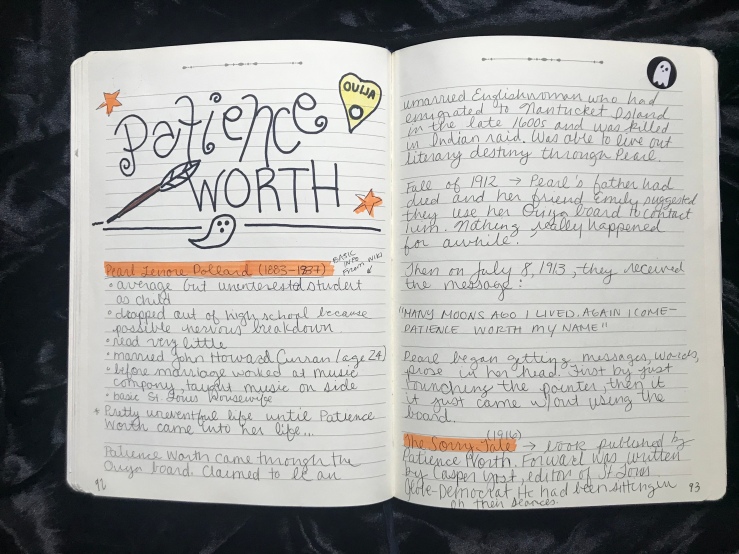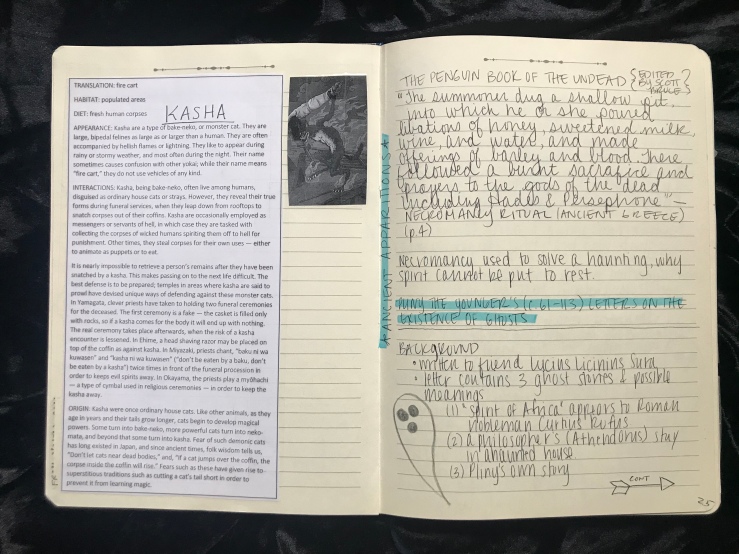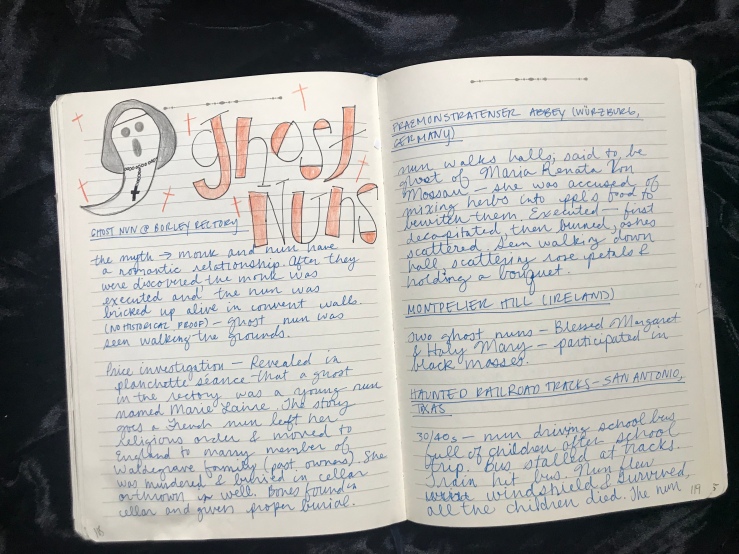
This blog began as a way to share the contents of my commonplace book. I thought I might discuss my routine for keeping a commonplace book. If you are new to commonplace books, I recommend reading my post “A Brief Guide to Keeping a Commonplace Book.” It provides a brief history and introduction, along with tips for starting one.
Now, I use the word “routine” lightly. Sometimes I stray from my usual routine. Sometimes, I’m not feeling it. Your process for keeping a commonplace book will be unique to you as a writer, reader, thinker, notetaker, and learner. I am sharing my process merely as an example; a process which took years to develop. I am very scattered generally, so I need to have habits in place.
The Sorting Weeks
During the sorting weeks, I gather preliminary research. I write about topics of interest to me. I email myself links. I take screenshots of tweets (especially during #FolkloreThursday). I take notes during public lectures, television shows, movies, etc. My method is chaotic and I have “notes” floating around everywhere. I takes notes on whatever is available.
At the end of the week (usually Sunday), I sit down with my pile of notes. I sort through them; placing them in four separate piles.
- Purgatory: Topics that need further research, but are placed on the backburner
- In Between: Facts and bits that don’t need their own section heading
- Finished: Full articles or finished notes
- To Pursue: 1 – 3 topics to pursue in the following week
I first put the purgatory topics on post-its and then place them inside the cover. I’ll return to those another day.
During the process of filling in my commonplace book, I’ll often begin entries before finishing prior ones, so I have to guess how much buffer pages I need between entries. I don’t stress about guessing correctly, because any leftover pages are perfect for those “random bits”: facts, new words and definitions, images of paintings I love (with artist name, date, etc.), quotes I love, and more. Those interesting enough to make the book, but don’t require its own entry (or listing in my table of contents), are called “In Between” pages (creative, I know). I usually put these in the book directly after obtaining them, or wait until the Sunday of a sorting week to write them in.
Sometimes I find articles that are so great that I want to keep them for future reference. Or, I took notes from a book that does not need further research. I put any finished or full-length articles in the book, making sure to update my Table of Contents. I just cut (if necessary) and paste (with a glue stick or tape) the articles into the book.

The Research Weeks
During the research weeks, I pursue a topic(s) of study. There won’t be a test at the end of this, so I’m merely pursuing a topic for the love of it. These topics have their own individual heading/section and are placed in my table of contents (my first blog post breaks down what an entry might look like).
What Commonplace Books Do
Commonplace books help with the following:
- Establishing habits of reflecting on interesting things you learn each day/week.
- Inspiring you to pursue a new area of study at any stage in your life
- Documenting and (loosely) organizing new knowledge sometimes lost in the inundation of daily (especially online) information
Commonplace Books for Lifelong Curiosity
Even after leaving academia, my desire to be a student, teacher, and researcher stayed with me. While I do have dreams of writing a book someday, I also love the idea of researching for the hell of it and with no final destination. I have always thought my time on earth would be best spent shoving as much knowledge into my head as possible. This is a worthy endeavor, but my brain can only hold so much. Enter: my commonplace book.
I love school. I love the process of solitary learning: reading/listening, taking notes, reviewing notes. There’s something about writing down what you just learned, like making a pact with history. I don’t think such habits or pursuits are just for academics or scholars. If you have a desire to learn, grab a blank notebook and start writing.

Commonplace Books as Ritual
Writing in my commonplace is a Sunday ritual. I light my favorite candle, make a cup of tea, and tidy up my workspace. Sometimes, I’ll do a quick 3-minute meditation. I have a playlist for this intellectual endeavor (Usually classical music. So, predictable right?). It is my time to focus on intellectual curiosity. When you want something to happen, you carve out time for it.
Commonplace Books in a Digital Age
I, like my reading habits, use a mix of digital and print during the process of commonplace booking. I read digital sources and I take notes using digital tools (emailing myself links, using iPhone Notes to collect info, voice recorders). I also take notes throughout the week using post-its and scraps of paper. My commonplace book ritual is a mix too. I cut, draw, write, turn the pages, pull books from my shelves. I also use the internet to research or print accompanying pictures.
You can keep a digital commonplace book (using programs such as Evernote, Microsoft OneNote, Mac Notebook, etc).
For me, I enjoy the ritual of physical book. It’s a time to step away from the screens for a bit.

Some Tips
I want to make one important point: commonplace books must not be pretty.
And by pretty, I mean those beautiful bullet journals you see on Instagram. Of course, you can make your entries a piece of art (I sometimes draw pictures or add stamps and stickers). Just don’t feel pressured to have the final product meets a particular standard. Don’t worry if your handwriting is not perfect. Enjoy the process of building a repository of knowledge!
If you do make a huge mistake, just glue some paper on top of it and make it a fun text box.
Find different ways to organize and highlight your data.
I love organizing complex information. I will organize content into tables and graphs to make the information easier to find later. I will also highlight, circle, or underline key terms or phrases (sometimes during a second reading). Other design elements you might incorporate: bullets, pull quotes, text boxes, sidebars, endnotes, footnotes, mindmaps, etc.
Don’t be afraid to “continue on page ___.”
My commonplace book can be rather chaotic. I’ll return to subjects later, only to find there’s no room left to continue that endeavor. Thus, I’m often continuing on future pages. Embrace organized chaos, just put guideposts along the way.
Your book should have your personal stamp.
Everyone learns differently. Maybe a commonplace book isn’t for you? Maybe you want a purely digital one? Maybe you want it a bit more organized than mine? Your book will be a representation of you, so do you!
If you start or already have a commonplace book, I’d love to see it and hear about your methods. Comment below or tag me on Instagram!

Love this! I have now realised why my notes are so scattered across books, apps, and devices, forever disorganised and getting lost – because I am not completing the final step: the commonplace book. This is exactly my kinda party! Thanks for sharing all your tips.
LikeLiked by 4 people
I’m so glad you found it helpful. 🙂
LikeLiked by 2 people
[…] My Commonplace Book Routine […]
LikeLike
[…] down your favorite quotes and excerpts! To learn more about commonplace books, read this post (and this post). To learn more about keeping a Halloween commonplace book, read this […]
LikeLike
I came across a NY Times story about commonplaces and my curiosity was piqued. I came to WordPress to search tags and found your thorough and interesting post. I’ve been keeping a small notebook(s) to record quotes I like as I read but I didn’t know it was a “thing”. I love your expanded version explained in this post – something to strive for. Here’s the link to the NY Times story, FYI. https://www.nytimes.com/2020/11/01/books/review/dwight-garner-garners-quotations.html?referringSource=articleShare
LikeLiked by 1 person
Thank you so much for the article link and for your kind words. 🙂
LikeLiked by 1 person
[…] quotes and excerpts! To learn more about commonplace books, read this post (and this post). To learn more about keeping a Halloween commonplace book, read this […]
LikeLike
[…] your favorite quotes and excerpts! To learn more about commonplace books, read this post (and this post). To learn more about keeping a Halloween commonplace book, read this […]
LikeLike
[…] quotes and excerpts! To learn more about commonplace books, read this post (and this post). To learn more about keeping a Halloween commonplace book, read this […]
LikeLike